Birdfinding.info ⇒ Common on Abaco, where it can be found at all of the frequently visited sites, and also on Eleuthera and Cat Island. On Andros it is locally common around Stafford Creek and Blue Holes National Park, less so elsewhere. On Grand Bahama it is generally uncommon but can be found consistently in the Lucayan Estates area and wilder areas at the east end of the island.
Bahama Yellowthroat
Geothlypis rostrata
Endemic to the northern Bahamas: Grand Bahama, Abaco, Andros, Eleuthera, Cat Island, and several adjacent cays, where it inhabits coppice woodland, thickets, scrub, and the understory of pine forests.
Formerly also inhabited New Providence, but was apparently extirpated in the late 1900s. In the 2000s, there have been a few sightings, likely wanderers from Andros. There have been a few sightings in southern Florida. Though none of these records has been accepted as certain, it seems likely that the species occurs there occasionally as a stealth vagrant.
Identification
A robust warbler that occurs mainly in dry habitats. Very similar to the widespread Common Yellowthroat which winters throughout its range, but distinctly larger and especially larger-billed.
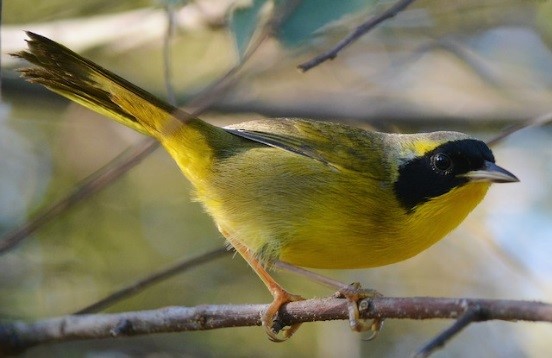
Bahama Yellowthroat, male, showing typically extensive bright yellow underparts. (North Abaco, Bahamas; January 2, 2017.) © Robert Norton
Males show significant variability in the details of their plumage. They are typically bright yellow below and bright olive above, with a bold black mask and grayish crown. However, some males are much duller overall and sometimes much more limited in the extent of their yellow coloration—often with irregular blotches.
The border between the male’s mask and the crown varies and can be either gray, whitish, yellow, or olive.

Bahama Yellowthroat, male with blotchy yellow patches extending beyond the throat, breast, and vent, and a pale-gray border between the mask and crown. (North Abaco, Bahamas; December 16, 2016.) © Erika Gates

Bahama Yellowthroat, male, showing typically extensive bright yellow underparts. © Gerlinde Taurer

Bahama Yellowthroat, male, showing extensive bright yellow underparts and yellow border between mask and crown. (Abaco National Park, Bahamas; March 24, 2017.) © Frank Salmon
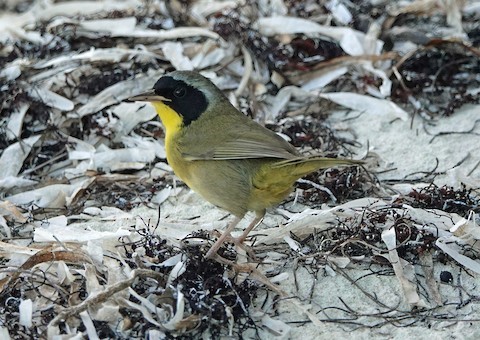
Bahama Yellowthroat, an atypically dull male, with yellow limited to the throat, upper breast, and vent, and medium-gray border between the mask and crown. (Powell Cay, Abaco, Bahamas; November 20, 2018.) © Jason Wilder
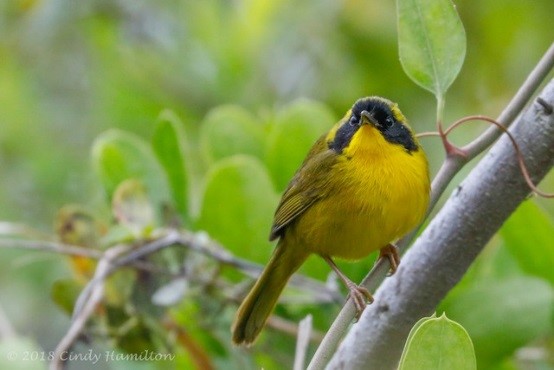
Bahama Yellowthroat, male, yellower than average. (North Abaco, Bahamas; April 23, 2018.) © Cindy Hamilton
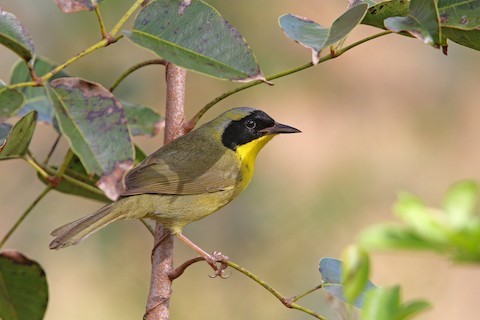
Bahama Yellowthroat, male, somewhat duller than average, with blotchy yellow on the crown and flanks. (The Y, South Abaco, Bahamas; January 6, 2013.) © Christoph Moning

Bahama Yellowthroat, an atypically dull male, with blotchy yellow on the breast, back, and vent, and pale-gray border between the mask and crown. (Central Abaco, Bahamas; January 11, 2013.) © Christoph Moning

Bahama Yellowthroat, male, showing long legs. (Captain Bill’s Blue Hole, North Andros, Bahamas; May 8, 2018.) © Richard Dunn
Females are also somewhat variable, generally yellow below and olive above, often with a distinctly grayer “helmet.” They usually show a sharp demarcation between the yellow of the throat and the gray or olive helmet.

Bahama Yellowthroat, female showing strong contrast between grayish helmet and bright yellow throat. (Powell Cay, Abaco, Bahamas; November 20, 2018.) © Jason Wilder

Bahama Yellowthroat, female showing large bill and strong contrast between grayish-olive helmet and bright yellow throat. (North Abaco, Bahamas; January 2, 2017.) © Robert Norton

Bahama Yellowthroat, female, yellower than average. (Casuarina Point, Abaco, Bahamas; December 7, 2015.) © Jason Estep
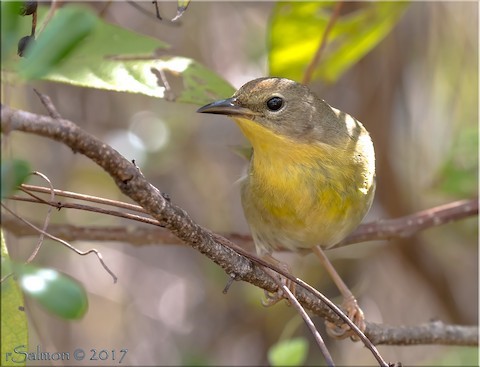
Bahama Yellowthroat, female showing strong contrast between grayish helmet and bright yellow throat. (Abaco National Park, Bahamas; March 24, 2017.) © Frank Salmon
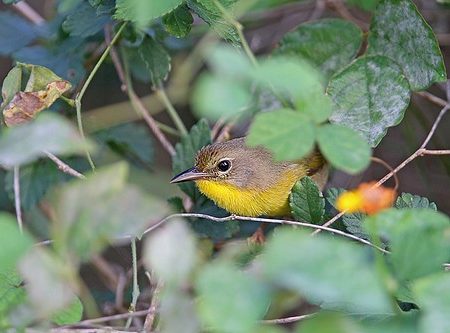
Bahama Yellowthroat, female showing strong contrast between grayish helmet and bright yellow throat. (North Abaco, Bahamas; January 7, 2013.) © Christoph Moning

Bahama Yellowthroat, female or possibly an immature male showing some blackish feathers that may be the early stage of a mask developing. (Central Abaco, Bahamas; December 15, 2018.) © Kent Forward
Juveniles resemble females but duller overall, with blotchy, irregular infusions of yellow on the throat, breast, and crown.
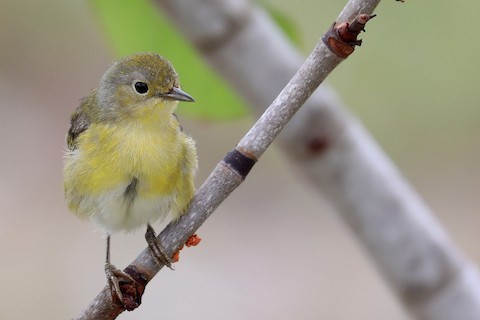
Bahama Yellowthroat, immature showing blotchy yellow infusions in its plumage. (Cape Eleuthera Institute, Eleuthera, Bahamas; June 15, 2019.) © Peter Kyne
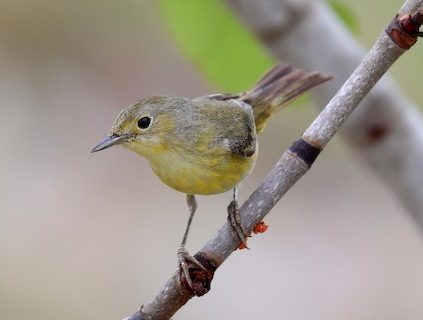
Bahama Yellowthroat, immature showing blotchy yellow infusions in its plumage. (Cape Eleuthera Institute, Eleuthera, Bahamas; June 15, 2019.) © Peter Kyne
Cf. Common Yellowthroat. The Common Yellowthroat is a common winter visitor throughout the Bahama Yellowthroat’s range, and the two are both highly variable and extremely similar, creating ample opportunity for confusion. Their habitat preferences differ, as Common is generally associated with marshes and grassy areas, whereas Bahama occurs mostly in dry thickets and brush, but they also overlap widely (especially when Common is on its wintering grounds) and both may occur in the preferred habitat of the other.
Bahama is about 15% larger in all dimensions than Common, with apparently longer legs. The most reliable size distinction is in the bill, as Bahama’s is longer, thicker, and slightly more decurved.
Male Bahama’s coloration tends to be brighter overall than male Common (particularly the subspecies most likely to occur with Bahama), but in most cases this is not a sufficient basis for identification—although the brightest male Bahamas clearly outshines the brightest male Commons. A characteristic of many male Bahamas’ plumage that may be diagnostic in some cases is the presence of irregular blotchy yellow staining beyond the throat, breast, and vent.
Female plumages appear to differ more consistently. Female Common is generally drabber and appears washed-out compared to female Bahama, which usually shows more extensive, brighter yellow on the underparts and stronger contrast between colors. In particular, female Bahamas have a sharp demarcation between the bright yellow of the throat and the gray or olive helmet. The contrast and the colors of female Bahama’s throat and helmet are stronger and more distinct than on most if not all female Commons.
Notes
Polytypic species consisting of four recognized subspecies.
References
Curson, J. 2019. Bahama Yellowthroat (Geothlypis rostrata). In Handbook of the Birds of the World Alive (J. del Hoyo, A. Elliott, J. Sargatal, D.A. Christie, and E. de Juana, eds.). Lynx Edicions, Barcelona. https://www.hbw.com/node/61511. (Accessed November 8, 2019.)
Curson, J., D. Quinn, and D. Beadle. 1994. Warblers of the Americas: An Identification Guide. Houghton Mifflin, Boston.
Dunn, J.L., and K.L. Garrett. 1997. A Field Guide to Warblers of North America. Houghton Mifflin, Boston.
eBird. 2019. eBird: An online database of bird distribution and abundance. Cornell Lab of Ornithology, Ithaca, N.Y. http://www.ebird.org. (Accessed November 8, 2019.)
Raffaele, H., J. Wiley, O. Garrido, A. Keith, and J. Raffaele. 1998. A Guide to the Birds of the West Indies. Princeton University Press, Princeton, N.J.
